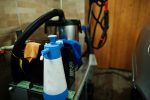As pet owners, you have a significant role to play in creating the perfect environment for your pets. Your pets depend entirely on you for their care and well-being. Whether you are a dog lover, a cat enthusiast, or you prefer the company of skunks, your pets need a caring, stimulating, and safe environment to thrive. This article focuses on enlightening you on how to design a stimulating indoor environment for your pet skunk. Skunks, just like dogs, cats, and other animals, also require love, care, and attention.
Understanding Skunks as Pets
Before embarking on creating an environment for your skunk, it’s essential to understand the nature and needs of these unique animals.
Also to see : What are the best fish species for a nano reef tank?
Skunks are not your typical pets like dogs or cats. Their distinct characteristics and behaviors set them apart from other domestic animals. Typically, skunks are nocturnal, meaning they are more active at night. They are also known to be curious creatures, always exploring and sniffing around.
Skunks are omnivores, consuming both plant and animal matter. Their diet ranges from insects, small rodents, fruits, eggs, and even garbage. This diverse dietary habit means skunks require a balanced meal to stay healthy.
In the same genre : How to choose the right type of harness for a brachycephalic dog breed?
Just like dogs and cats, skunks also need regular veterinary care. Regular check-ups will ensure they remain healthy and free from diseases. Some skunks are prone to obesity, dental issues, and other health problems if not cared for properly.
Creating the Perfect Indoor Environment
Creating a stimulating environment for your pet skunk involves more than just providing food and shelter. It requires time and dedication to ensure that your skunk feels comfortable, safe, and engaged.
Start by providing a spacious and comfortable enclosure for your skunk. Skunks are active animals and require enough space to move around. A small cage or enclosure might lead to stress, boredom, and health issues. Make sure the enclosure is well ventilated, clean, and free from harmful materials.
Skunks are naturally curious creatures. Hence, providing them with a variety of toys will keep them engaged and stimulated. You can use cat or dog toys, balls, or even homemade toys. Skunks love to play hide-and-seek, so you can include a small box or tube where they can hide.
Another crucial factor to consider when creating an indoor environment for your skunk is safety. Ensure the environment is free from harmful substances and objects that your skunk might ingest. Skunks are known to chew on items, so make sure there are no plastic materials, wires, or small objects that they can swallow.
Dietary Requirements
Just as with dogs and cats, a balanced diet is essential in maintaining a healthy skunk. Skunks are omnivores and require a variety of foods to meet their nutritional needs.
A balanced diet for your skunk should include proteins, carbohydrates, and fats. Sources of proteins include chicken, turkey, and eggs. Carbohydrates can be obtained from fruits and vegetables like apples, pears, and carrots. Fats, on the other hand, can be sourced from nuts and fish oil.
Avoid feeding your skunk with dog or cat food as these do not meet their nutritional needs. Also, do not feed your skunk with too many fruits as they can lead to obesity.
Ensure that you provide fresh water for your skunk every day. Like other animals, skunks require a constant supply of water to stay hydrated.
Regular Vet Check-ups
Regular vet check-ups are essential in keeping your skunk healthy and happy. Skunks are susceptible to various health issues, including obesity, dental problems, and parasites. Regular veterinary care will help detect these issues early and provide the necessary treatment.
Just like you would with your dogs or cats, ensure your skunk is vaccinated against common diseases like rabies and distemper. Regular deworming is also necessary to keep your skunk free from parasites.
Regular grooming is also essential for your pet skunk. Skunks have a thick and soft fur that requires regular brushing. Grooming your skunk will not only keep them looking good but also help you bond with them.
Training and Socialization
Training and socialization are critical aspects of pet care, whether you are dealing with dogs, cats, or skunks. Skunks are intelligent animals and can be trained to use a litter box, just like cats. They can also be trained to respond to their names and perform simple tasks.
Socialization is also critical for your pet skunk. Expose your skunk to different environments, people, and other pets. This will help them become comfortable in various situations and reduce their chances of becoming aggressive or fearful.
In conclusion, owning a skunk as a pet is a unique experience. With patience, time, and the right care, you can create a stimulating indoor environment for your pet skunk.
Suitable Skunk Entertainment
It’s essential to remember that skunks are naturally curious and intelligent animals. Just like dogs or cats, they crave mental stimulation and physical activity in their environment. A variety of toys and play activities go a long way in keeping your pet skunk entertained and engaged.
Consider introducing various forms of enrichment into your skunk’s environment. Skunks are diggers by nature, so provide an area within their enclosure where they can dig. This could be a box filled with safe, non-toxic materials like shredded paper or sand.
Toys such as balls, puzzle feeders, and safe chew toys are also excellent for stimulating their minds. Remember to switch out the toys regularly to keep their interest piqued. Puzzle feeders, in specific, can stimulate their problem-solving skills while also providing a fun way to get their meals.
Skunks also enjoy playing hide-and-seek. A simple cardboard box with holes cut into it can provide hours of entertainment. The step jpg of a homemade skunk toy can be found on many pet care websites and in the wikihow images section as visual guides.
Including various types of interactive toys and activities in your indoor environment helps to keep your skunk physically active, mentally sharp, and properly stimulated.
Ensuring Your Skunk’s Safety
Safety should be a primary concern when creating a stimulating indoor environment for your pet skunk. Keeping the environment safe means removing all harmful substances and objects that your skunk might ingest or harm themselves with.
Skunks are known to chew on items, so remove all plastic materials, wires, or small objects they could potentially swallow. Bigheight licensing toys and chewable items are recommended as they are typically larger and safer for skunks.
Secure all electrical cords and outlets, and verify that no toxic plants are accessible to your pet. Also, be sure to childproof all cabinets, as skunks are adept at opening them and could potentially ingest harmful substances.
Additionally, ensure that all smallwidth smallheight areas, such as gaps behind furniture or appliances, are blocked off. Skunks can squeeze into surprisingly small spaces and could become trapped or injured.
Skunks are not climbers by nature, but they are curious and may attempt to climb on furniture or shelves. To prevent falls, you can consider "skunk-proofing" your home similar to baby-proofing.
In conclusion, creating a stimulating environment for a pet skunk requires understanding their natural behaviors, providing a balanced diet, giving them the correct amount of mental and physical stimulation, and ensuring their safety at all times. It may seem like a daunting task, but with patience and dedication, you can provide a loving and stimulating home for your unique pet.






